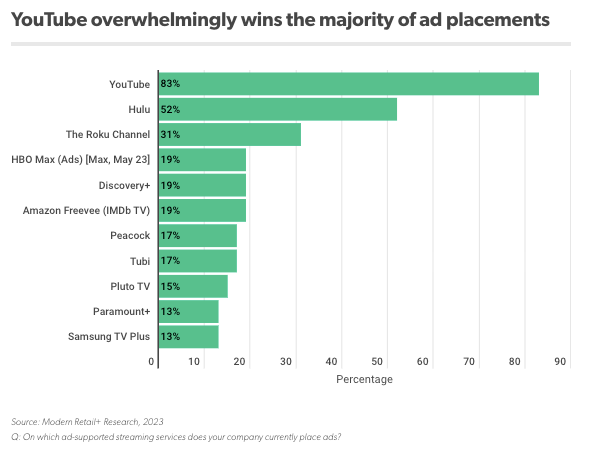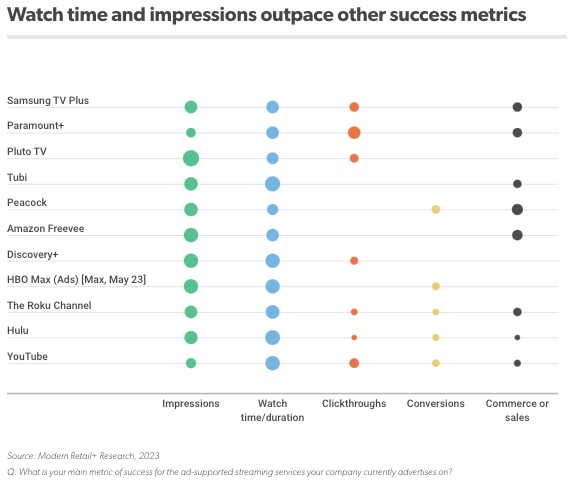Research Briefing: Amazon creates new revenue stream with ads on Prime Video

Welcome to the Modern Retail+ Research Briefing, your weekly curation of retail, technology and marketing research insights. As a member, you have full access to the Modern Retail+ Research below.
In this edition, we share focal points from Modern Retail’s CMO Strategies series report that focuses on ad-supported streaming.
Interested in sharing your perspectives on the future of retail, technology and marketing?
Apply to join the Modern Retail research panel.
Majority of marketers say view duration is the main KPI for ad-supported streaming
Last week, we discussed Amazon’s investment in AI startup Anthropic. This week, we are continuing our analysis of Amazon and its recent announcement that it’s adding ads to Prime Video. The addition of ads into streaming is not a new concept. Other large streaming platforms, such as Disney+ and Netflix, have also joined this trend recently. The strategy for many of these platforms is clear — generate new ad revenue through an ad-supported tier while at the same time creating a new subscription tier with a higher cost to opt-out of ads. Though notably, Amazon already offered Amazon Freevee, which is an ad-supported streaming service.
For advertisers, this can be an exciting opportunity to diversify their portfolios of streaming services. According to a recent study conducted by Modern Retail+ Research, YouTube receives the majority of advertisers’ ad placements, with 83% of survey respondents saying their company places ads on YouTube. But as Amazon, and other competitors, enter the ad-supported streaming business, the pie will likely start shifting. Established ad-supported streaming platforms may have to start diversifying their products or content to compete with new, larger entrants into the market. But, from a marketer’s perspective, marketers are the primary winners because they’re gaining access to new customers.

Ad-supported streaming services can play a key part in the marketing funnel for brands, as the ads placed on them are typically used to drive brand awareness. Among the marketers Modern Retail+ Research surveyed, watch time/view duration/average completion rate was the No. 1 success metric they consider for ad-supported streaming services: 48% of respondents said this constellation of attention metrics was most important for Hulu; 45% percent said so for YouTube; and 40% said the same for The Roku Channel. This makes sense due to the nature of the ad environment itself, but also emphasizes an awareness play, rather than a focus on conversion.

Depending on the ad product formats that Amazon introduces, the retail giant may attract different types of brands. The main two ad formats it’s likely to introduce are skippable and non-skippable ads. Skippable ads are great for larger brands that want to remind customers of their products, but many customers skip past the ads, which can cause the ads to lose their full impact. On the other hand, non-skippable ads are good for building brand awareness, but could annoy customers and create a negative impression of a brand.
When Modern Retail spoke to Cheryl Gresham, who is currently CMO at Verizon Value and who was CMO at Verizon’s Visible at the time of our interview, she said her company monitors how many of their video ads are skippable versus non-skippable, in addition to assessing how well customers receive the ads. “It’s something we watch closely,” Gresham said. “For us, with such low brand awareness, we have to ensure that we have a certain amount [of ads] that are non-skippable. However, we use a lot of social listening to see if we’re breaking through with people. Is the message resonating with them, or is it upsetting them?”
Key findings:
- According to a recent study conducted by Modern Retail+ Research, YouTube receives the majority of advertisers’ ad placements at 83% of respondents. But as Amazon, and other competitors, enter the ad-supported streaming business, the pie will likely start shifting.
- Depending on the ad product formats that Amazon introduces, it may attract different types of brands. The main two formats are skippable and non-skippable ads. Skippable ads are great for larger brands that want to remind customers of their products, but many customers skip past the ads, which can cause the ads to lose their full impact. On the other hand, non-skippable ads are good for building brand awareness, but could annoy customers and create a negative impression of a brand.
READ MORE ABOUT AD-SUPPORTED STREAMING
See research from all Digiday Media Brands:

